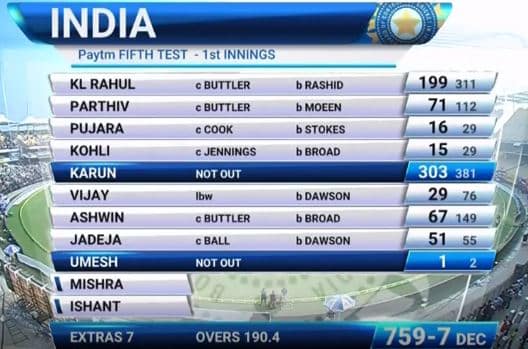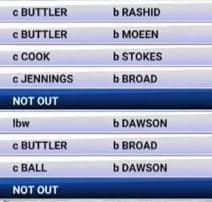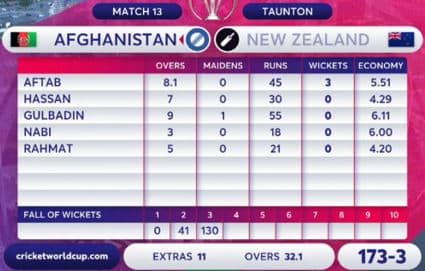I’ve tried to convince a lot of my friends to start watching cricket over the years, and often the first question I’ll get asked is about the scoring rules. They’ll usually ask something like ‘What’s the difference between a 4 and a 6?’ or ‘what does 100-2 mean?’. Sometimes the questions are as simple as ‘what is a wide?’ or ‘what is a wicket?’.
If you’re reading this and thinking that you’re unsure of the answers to any of those questions above, then this blog post is a great place for you to start. Here I’ll explain all of the key scoring rules that are likely to play a part in a cricket match, and hopefully get rid of a lot of the confusion for you!
In this post we’ll go through the following questions:
- What Are Runs & How They Are Scored?
- What Is A Wicket & Which Ones Are Awarded To The Bowler?
- What Are ‘Extras’ & How Many Runs Do You Get For Each Type?
- What Are The Different Types Of Penalty Runs?
- How Do You Read A Cricket Scorecard?
Now let’s get in to it…
What Are Runs & How Are They Scored?
Even if you only have a slight interest in cricket, you should know that the main goal of the batting team is to score as many runs as possible. Great batting performances are one of the enjoyable aspects of the game, and if you want to enjoy them fully you’ll need to understand what’s going on!
In this section we’re going to focus on runs that are scored directly by the batsmen. It’s actually really simple!
Firstly, you need to be aware that during a batting innings there are always two batsmen on the pitch at the same time. One will be stood at the strikers end and will receive the ball from the bowler. The second batsman will stand at other end of the pitch (called the non-strikers end) until they are called upon. The next thing you need to understand is that batsmen can score runs in two ways: hitting the ball over the boundary, or running between the wickets. I’ll cover the running between the wickets part first.
Running Between The Wickets
If a batsman hits the ball into a gap in the field causing the fielders to chase after the ball, then both batsmen should immediately begin to run between the wickets. For 1 run to be completed, both batsmen that are on the pitch must make it to the opposite set of wickets once and land part of their body (or bat) on the ground behind the line of the crease. If both batsmen make it to their destination, 1 run will be added to the score of the batsman who received the ball from the bowler, as well as the total of the batting team.
To score 2 runs, both batsman must run to the opposite set of stumps, ground their body or bat behind the line of the crease and then run back to the end where they started, grounding their body or bat behind the crease once again. Like before, the 2 runs would only be credited to the batsman who struck the ball.
This pattern continues if the batsmen want to run 3, 4, 5 or even 6 runs! Every time you increase the number of runs, it means that both batsmen have to run between the stumps one more time, grounding their body/bat behind the line of the crease before each turn. You don’t often see batsmen score more than 3 runs by running between the wickets, because most cricket pitches simply aren’t big enough! It takes a long time for players to run between the stumps 3 times, and often by this time the fielding team has recovered the ball and will be trying to throw it to the wicket keeper to run them out. To avoid being run out, both batsmen must remain behind the line of the crease at opposite ends of the wicket.
Hitting Boundaries
Every cricket pitch has a circular ring around its edge that signifies the limit of the playing area. This ring is called the boundary. Sometimes the boundary will be represented by painting a white line on the grass, sometimes it will be represented by a rope, and sometimes there will be a rope as well as some soft padding on top to make the boundary more noticeable.
Scoring runs due to hitting the ball over the boundary is very easy for the casual observer to understand. The basic rule is as follows: If the batsman hits the ball over the boundary line without it bouncing first, that batsman will be awarded 6 runs. If the batsman hits the ball and it bounces inside the field of play before travelling over the boundary line, then that batsman shall be awarded 4 runs.
When a batsman hits a powerful shot that they think may travel over the boundary line, they may choose to run between the wickets with their batting partner just in case the fielding side stops the ball from going for 4 or 6. This way, they will still get some runs for the shot they have played! If the batsmen thought the ball was going to go over the boundary, chose not to run between the wickets, and then the ball was stopped by the fielding team, they would receive zero runs! This would not be ideal.
If the batsmen run between the wickets AND the ball goes over the boundary line for 4 or 6, the number of runs that the batsmen ran for does not get added to the shot total. For example, if you hit a shot for 4, but run 3 runs between the wickets while the ball is on its way to the boundary, the batsman does not receive 7 runs for this shot. They simply receive the boundary total, which in this case would be 4!
What Is A Wicket & Which Ones Are Awarded To The Bowler?
‘Wickets’ are another important cricket statistic, and they’re recorded on all cricket scorecards. The bowling team is awarded 1 wicket when they dismiss one of the opposing batsmen. There are ten ways in which batsmen can be dismissed, and they are as follows:
- Bowled
- LBW
- Caught
- Run Out
- Stumped
- Hit Wicket
- Obstructing the Field
- Hitting the Ball Twice
- Timed Out
- Retired Out
Given that cricket teams have 11 players, the bowling team must take 10 wickets to end the innings of the batting team. The reason that the bowling team does not have to take 11 wickets is because there needs to be 2 batsmen at the crease at all times. If 10 wickets have been taken, there is only 1 batsman remaining! This batsman will remain ‘not out’ at the end of the innings.
As I mentioned a couple of paragraphs ago, there are ten different ways that the bowling team can get wickets. However, only 5 of these are credited to the bowler in their match statistics! The types of wicket that are credited to the bowler specifically are the following ones:
- Bowled
- LBW
- Caught
- Stumped
- Hit Wicket
All of these types of dismissal usually rely on some amount of skill by the bowler, unless the batsman makes a huge mistake or plays a ridiculous shot. The other types of dismissals are based more around the skill of the fielders, the choices of the batsman, or disobeying the rules of the game.
What Are ‘Extras’ & How Many Runs Do You Get For Each Type?
Extras in cricket are runs that are awarded to the batting team, but not to any specific batsman. This is because these runs aren’t scored as a result of the batsman striking the ball with the bat. The umpire is the individual responsible for declaring extras and having them added to the batting team total. Extras are recorded separately from the individual scores of the batsmen on all cricket scorecards.
There are 4 main types of extras. Here they are:
- No Balls
- Wides
- Byes
- Leg Byes
Let’s go through each of these in more detail.
What Are No Balls?
A no ball is an illegal delivery that does not lie within the rules of the game, and therefore needs to be bowled again. Bowling a no ball will also add 1 run to the batting team total. There are ten different ways that bowlers can bowl no balls, and you can ready the full breakdown of all of these in one of my other posts by clicking here!
If the umpire believes the bowler is guilty of a no ball, they must give the no ball signal. This is shown below! At this point the 1 run will be added to the total of the batting team.
No balls are counted as runs conceded in final match statistics for the bowler who was responsible for the delivery.

What Is A Wide?
A wide is an illegal delivery bowled by the bowler that is too wide of the batsman for them to hit. As a result, it will need to be bowled again. A delivery can be deemed to be a wide no matter which side of the batsman it passes. Wides can even be given if the ball passes unreasonably high over the batsman’s head!
The umpires are responsible for deciding which deliveries are wide deliveries. If the umpire believes a wide has been bowled, they must give a signal which is shown in the photo below. At this point, 1 run is added to the total of the batting side.
The decision on whether a delivery is wide or not must be made at the point when the ball passes the batsman, not before or after. For example, if the bowler bowls a ball that starts off very wide but then swings in towards the batsman’s body as it reaches them, this delivery cannot be classed as a wide. Conversely, if the ball starts off on a straight line, but then deviates off the pitch so much that the batsman can no longer hit it, this should be classed as a wide.
If the ball is so wide that it causes the wicketkeeper/fielders to not recover it quickly, the batsmen can begin to run between the wickets. Any runs that they achieve in this way will be added to the total of the batting team as wides. These runs will not be added to the individual score of the batsman. In addition to this, if a wide ball travels over the boundary rope, then 4/6 wides will be added to the batting team total.
Wides are counted as runs conceded in final match statistics for the bowler who was responsible for the delivery.
What Are Byes?
If a legal delivery passes the batsman without hitting their bat or any part of their body, and the fielders/wicketkeeper do not recover it quickly, the batsman can begin to run between the wickets. Any runs that the batsman takes here are classed as byes, and are generally said to be the fault of the fielders/wicketkeeper. If a legal delivery passes the batsman without hitting their bat or any part of their body, and then goes on to pass over the boundary rope, then this will be given as 4 or 6 byes by the umpire.
When signalling byes, the umpire will make the following movement, shown in the picture below.
Any runs given as byes are not credited to the batsman, instead they will be added to the team batting total and shown separately as extras on the cricket scorecard. Byes are not counted against the bowler who delivered the ball, and as a result will not be shown in their final match stats.
What Are Leg Byes?
If the ball strikes the body of the batsman and travels out of reach of the fielders, it is possible for the batsmen to run leg byes. If the ball deflects off their body and goes over the boundary rope, they will receive 4/6 leg byes! The umpire will signal leg byes by making the movement shown in the picture below!
There are a few more things you need to remember about leg byes:
- If the ball deflects off the batsman’s bat or gloves, then any runs scored cannot be classed as leg byes. These will be counted as normal runs instead!
- If the batsman wants to run leg byes, they need to have either attempted to play a shot or attempted to evade the ball! If they just let the ball hit their body and don’t at least make some sort of movement towards/away from the ball, the umpire will call dead ball if any runs are scored.
- The equipment that the batsman is wearing is seen as an extension of their body, so if the ball deflects off the helmet while the batsman is attempting to play a shot, leg byes can be given.
Leg byes are added to the final total of the batting team, and are not credited to any individual batsmen. Leg byes are not counted against the bowler who delivered the ball in their final match statistics.
What Are The Different Types Of Penalty Runs?
There are certain rare instances in cricket where one team or one player will break a rule, and this will result in the umpire awarding 5 runs to the opposing team. Runs awarded in this way are known as ‘penalty runs’. In this section I’m going to list the main offences for which penalty runs can be given. Here we go:
- Players entering or returning to the field without the permission of the umpire and fielding/coming into contact with the ball while it is in play.
- Practicing on the pitch or on the rest of the square/outfield at the wrong times during a match. The umpires consent should always be sought on matters like this. Failure to do so may result in penalty runs being given to the other team.
- Illegally fielding the ball by using anything other than your body to do so. This includes using pieces of clothing or your equipment to field the ball
- If the ball strikes a helmet that is being stored on the pitch by the fielding side.
- If the umpire determines that the fielding side has repeatedly engaged in play that they deem to be ‘unfair’. This includes things such as deliberately damaging the pitch, encroaching on to the protected area of the pitch
- If the umpire considers that a player engages in repeated unacceptable conduct at any time during the match.
To signal penalty runs, the umpire will lift up one of their arms and touch their opposite shoulder. If you see the umpire tap their hand on the shoulder, that means the runs are being awarded to the batting side. If the hand is simply placed on the shoulder, the runs will be awarded to the bowling side. This will look something like the photo below!
How Do You Read A Cricket Scorecard?
Batting Scorecard
The photo below shows a typical cricket scorecard for a batting innings. Some people who are new to cricket struggle to know what all the different parts of this scorecard mean! So I thought I’d take a bit of time to explain it.

Let’s start on the right. The section of the scorecard I’ve cropped below shows the runs scored by each individual batsman, as well as the number of balls they have faced. The runs scored is on the left, with the number of balls faced on the right. Some scorecards will show the number of balls faced in brackets instead!

Now for the bottom section of the scorecard, shown below. This section contains the extras, the number of overs and the overall score of the batting team, which is arguably the most important bit. Now for the part at the bottom. As we’ve already covered, the extras section includes all of the runs that have been given to the batting side as a result of no balls, wides, byes and leg byes. The overs section is simply just the number of overs that have been bowled in that innings by the bowling team. The other part includes the score. In the screenshot below you can see that the score reads ‘759 – 7 dec’. The 759 refers to how many runs have been scored in total, including all of the individual scores of the batsmen and any extras that have been accumulated. The 7 refers to how many wickets the bowling side have taken. ‘Dec’ tells you that the batting side has chosen to ‘declare’ their innings, meaning that it will end immediately. Remember, not all scorecards show the score before the number of wickets! Most Australian scorecards are the opposite and will often read 7 – 759 instead!

The middle section of the scorecard (shown below) tells you how each batsman was dismissed. Any batsmen that have yet to be dismissed will have ‘not out’ written in this section.

Bowling Scorecard
The photo below shows a typical bowling scorecard. I think these are much easier to understand than a batting scorecard!

You have the overs that each individual bowler has bowled next to their name, as well as the total overs bowled in the innings at the bottom of the scorecard.
This scorecard also includes the number of maidens each bowler has bowled, how many runs they’ve conceded, and how many wickets they’ve taken. In addition to this, you’ll see the economy at the end. The economy of each individual bowler is the average number of runs they will concede for every over that they bowl. You can work this out by dividing the number of runs that bowler has conceded by the number of overs they’ve bowled!
The ‘fall of wickets’ section shows you what the score of the batting team was when each individual wicket was taken.
As I covered in the previous section, ‘extras’ refers to how many no balls, wides, byes and leg byes have been conceded by the bowling team, and ‘173 – 3’ shows the current score. That is 173 runs for the loss of 3 wickets.
Conclusion
I hope this post will serve as a reference point for many of you that are trying to learn the rules of the game. Feel free to comment down below and let me know if there’s any other aspects of scoring that I may have missed!
